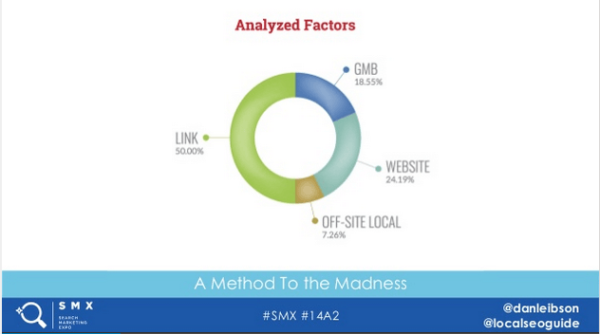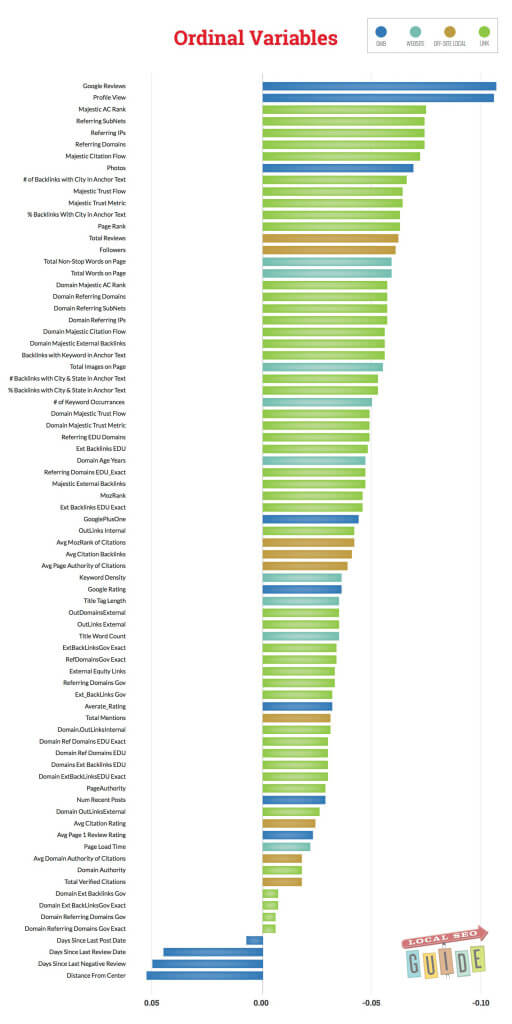Results from the Local SEO Ranking Factors Study presented at SMX East
Wonder what factors correlate with strong local rankings? Contributor Christine Churchill summarizes the results of a recent local ranking factors study presented at SMX East 2016.

The SMX East Session “The 2016 Quantitative Local SEO Ranking Factors Study” presented by Local SEO Guide‘s Dan Leibson (Vice President of Local & Product) and Andrew Shotland (President) explored the results of their recent study analyzing and prioritizing ranking factors that affect local search.
Unlike many studies that simply summarize search marketing experts’ opinions, the Local SEO Guide study took actual quantitative data as input. Leibson and Shotland teamed with competitive intelligence tool maker Places Scout and statisticians from the University of California, Irvine. By partnering with the University’s Center for Statistical Consulting, they ensured the study results were independent and withstood objective statistical analysis.
Their presentation, entitled “Reverse Engineering Google’s Local Search Algorithm,” highlighted the main findings of their study. It is important to remember that the results of the study reveal correlations, not causations. The study identified characteristics of sites that ranked well; it does not definitively say these characteristics are ranking factors.
The study assembled data from over 100 different ranking factors, 30,000 businesses and 3,000 local searches. Factors analyzed in the study included Google My Business listings, on-site website factors, off-site local factors (including citations) and links. Industry standard link tools Majestic and Moz were used for collecting link metrics.
(For more details on the methodology used, visit Local Search Ranking Factors Study on the Local SEO Guide website.)

Factors Analyzed in Local Search Study
The goal of the study was to identify factors that mattered in Google Local 3-Pack and Maps search so that business owners could have actionable data showing what to allocate resources and efforts towards with the goal of improving their local search performance.
The results proved that to succeed in local search, the online marketer needs to pay attention to areas not normally considered in local search — namely, links and website optimization.
Ordinal and categorical variables
The study segmented the ranking factors into Ordinal and Categorical variables. Ordinal Variables were numeric based factors, and sites with higher values for these factors ranked higher. Categorical Variables were Yes/No — if a business had this top-rated characteristic, it tended to rank higher.

Ordinal variables included in the study
The chart below shows the factors included as Categorical variables (usually a yes/no test) for various ranking factors, again ranked by perceived weight.

Categorical factors
Many of these factors fall into “foundational SEO” or “foundational Google My Business” factors, which are basic best practices and under the site owner’s control.
For example, Google My Business factors like having an Owner Verified (OV) listing or including business hours and photos are easy to do, and these factors will differentiate your site from those who don’t take these basic steps. The takeaway here was that it’s worthwhile to allocate time to build out a robust Google My Business profile.
Reviews matter
Two Google My Business (GMB) factors topped the list: reviews and profile views (though the latter is more a correlation than a factor — top pages get more views rather than the other way around).
Google reviews came in at the top of the list. The sites with the most reviews outranked other businesses. It may be that sites with more reviews get more clicks, but the fact that sites with more reviews ranked at the top is a strong indication that local companies should ensure they have reviews.
Another GMB factor was the presence of photos. This factor came in at the eighth position, followed closely by having an owner verified profile and including business hours. Again, taking the time to build out a quality GMB profile is seen as positive.
Moving towards traditional organic factors
The results of the study confirmed what many in the local search field have suspected: namely, that Google is moving more toward using traditional organic algorithm ranking factors and applying them to local search.
Activities that benefit organic SEO also benefit local search. Links, in particular, proved to be a large factor in local search, with various link metrics taking 10 of the top 15 ranking factors. Links have long been considered a major ranking factor in regular organic search. Going forward, local businesses need to pay attention to their linkage data just as in regular search.
Other actions that are recommended for organic SEO should also be applied to local SEO. Having a secure site, using keywords in backlink anchor text, and having keywords in the title were shown to be characteristics of sites ranking well in the study. Keywords in the business name showed up as a strong positive factor. It is not suggested that you abuse this, but if you are starting a new business, this might be something to keep in mind.
Having a mobile-friendly site came in as the third highest Categorical factor, emphasizing that Google’s shift toward favoring mobile-friendly sites is universal. Google has been saying mobile is a ranking factor in regular organic search, and it appears to help local as well, although sites which are mobile friendly have often had numerous other optimizations done.
“Near me” queries
In this session, Leibson also presented new results for “near me” type queries. The core takeaway on the “near me” queries is that the anchor text profile of links is important for ranking for those types of queries.
Having both a higher raw number and a higher percentage of backlinks with [city] in anchor text, and [city/state] in anchor text correlated with positive pack rankings for “near me” queries, much more so than those same signals showed for non-“near me” local searches.
Time & money investment chart
To help webmasters know where to prioritize their efforts, Dan and Andrew created their recommended investment chart that shows where to invest your resources for the highest payoff. Link work, followed by website optimization, will provide a big payoff in local search.

Chart showing where to invest your time in local search
Since traditional SEO best practices were included in the characteristics of ranking sites, local businesses might want to ensure that they allot time to improve their website if they want to stay competitive in local search.
The study revealed that local businesses need to go beyond just doing GMB and local citations in a vacuum. They still need to do normal local search work like gathering reviews, developing a robust local profile and citation building, but these are prerequisites. Webmasters need to do all the local work plus traditional SEO.
The true value of this study is that it brings quantitative data to an area that has long been dominated by opinions. The results give marketers insights on where to place emphasis and allocate resources in their optimization efforts.
Local Search Guide plans to repeat the study next year. It will be interesting to see how factors change as Google moves more toward more artificial intelligence influencing the ranking algorithm.
https://www.slideshare.net/slideshow/embed_code/key/N26djCwuDnRliZ
Contributing authors are invited to create content for Search Engine Land and are chosen for their expertise and contribution to the search community. Our contributors work under the oversight of the editorial staff and contributions are checked for quality and relevance to our readers. The opinions they express are their own.
Related stories
New on Search Engine Land